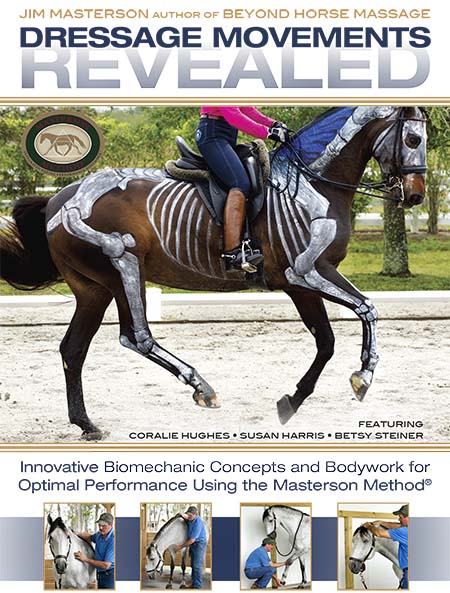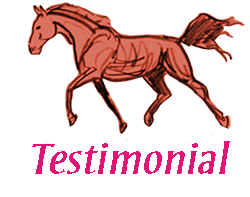This unique video will appeal to dressage riders, trainers and bodywork practitioners alike. Grand Prix horse, Bacchus, is painted with the skeleton and the major muscles. Betsy Steiner, internationally recognized dressage rider and trainer, performs the movements of upper level dressage which are filmed from multiple angles.

The video discusses the movements shown in slow motion from the anatomical/biomechanical point of view, the rider’s point of view and the bodyworker’s point of view.
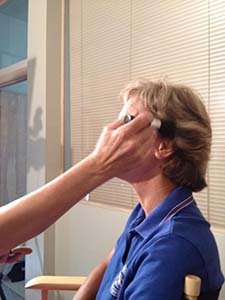
The last portion of the video features Jim Masterson working on one of Betsy’s dressage horses, highlighting new techniques that have arisen out of Coralie’s bodywork practice that focuses on dressage horses.
I watched all 175 minutes of Dressage Movements Revealed this weekend. I thoroughly enjoyed the graphics, discussions and demonstrations, what a great educational tool. I can’t wait for more time to re-watch the videos again…..and again! Job well done and what a valuable resource to educate equestrians about the bones, muscles, tendons, and nervous system of the horse. It is so important to understand the fundamental biomechanic that muscles work in pairs, one to contract, one to release. The kind of equine body work you teach, allows the horse to relax and release, and supports all the components of the training pyramid. Our dressage club, Great River Classical Horsemanship Association, bought the video as a club resource and we will be passing it around to our winter study groups. I know it will create lots of opportunity for good conversations and be a positive influence on our relationship with our horse and add to the comfort, longevity, health, happiness and performance of our riding partners. Thank you to everyone involved in this effort and thank you for producing this video.
Sincerely, Ann B, Windrush Hill Farm, Mount Pleasant, Iowa
Coralie teaches 3 day Dressage Movements Revealed Course!
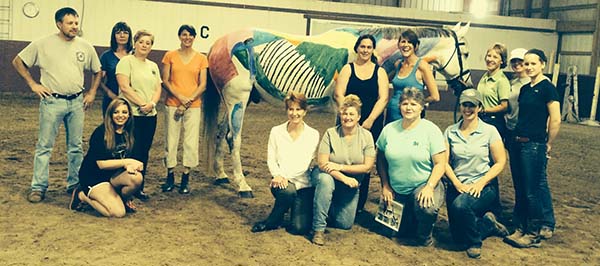 The new Masterson Method bodywork course based on the Dressage Movements Revealed project was held July 11-13 at Coralie’s farm (course instructor) in Coatesville, Indiana, ably assisted by MMCP Cheryl Fell. Twelve students attended, 8 of whom had previously attended a weekend seminar, 2 having also attended the advanced class. Four of the students had no previous exposure to the method. Seven of the students were USDF (United States Dressage Federation) members and were happy to receive USDF University credits for attending.
The new Masterson Method bodywork course based on the Dressage Movements Revealed project was held July 11-13 at Coralie’s farm (course instructor) in Coatesville, Indiana, ably assisted by MMCP Cheryl Fell. Twelve students attended, 8 of whom had previously attended a weekend seminar, 2 having also attended the advanced class. Four of the students had no previous exposure to the method. Seven of the students were USDF (United States Dressage Federation) members and were happy to receive USDF University credits for attending.
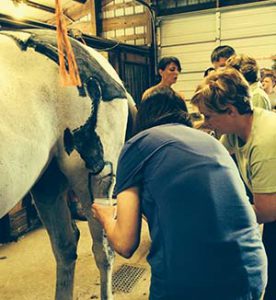 The DMR course expands beyond the traditional weekend course both in terms of content and techniques taught. The goal of the three day program is to connect biomechanics of dressage (which actually applies to biomechanics of most disciplines to at least some extent) to bodywork on the dressage horse, who typically presents with discipline specific areas of restriction and tightness.
The DMR course expands beyond the traditional weekend course both in terms of content and techniques taught. The goal of the three day program is to connect biomechanics of dressage (which actually applies to biomechanics of most disciplines to at least some extent) to bodywork on the dressage horse, who typically presents with discipline specific areas of restriction and tightness.
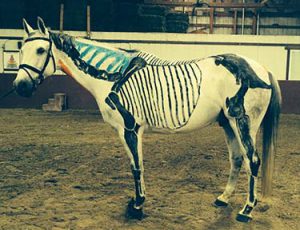 The first day began with an introduction to the Masterson Method. There was a 20-30 minute discussion of the framework of the equine skeleton and how it needs to be able to move, especially focusing on the atlanto-occipital joint, the neck vertebrae, the scapula, how the hind legs attach to the axial skeleton, how the back works in longitudinal and lateral flexion, and the rotational ability of the hip joint. The rest of the day was spent learning and practicing the front end techniques taught in the weekend class plus a series of simple but highly effective techniques designed to further loosen up shoulders and neck in the dressage horse.
The first day began with an introduction to the Masterson Method. There was a 20-30 minute discussion of the framework of the equine skeleton and how it needs to be able to move, especially focusing on the atlanto-occipital joint, the neck vertebrae, the scapula, how the hind legs attach to the axial skeleton, how the back works in longitudinal and lateral flexion, and the rotational ability of the hip joint. The rest of the day was spent learning and practicing the front end techniques taught in the weekend class plus a series of simple but highly effective techniques designed to further loosen up shoulders and neck in the dressage horse.
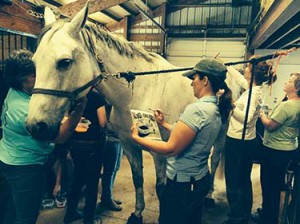 The second day started with a review of the first day’s techniques asking two questions: what is the purpose of the technique and what does “well done” look like. We then had a 30-45 minute discussion of the muscle anatomy. Instead of using a lot of latin names and talking about attachment points and locations, we discussed the muscles in terms of functional muscle anatomy: how pairs have to work together to move a part of the skeleton (one relaxing and one contracting), how a system of muscles controls a larger area such as the poll, the shoulder or the haunches (for example which muscle clusters move a leg forward or back, away from the body and move the body over the planted leg), and finally how the muscles link in chains over the top line and also ventrally (from the jaw, under the neck, along the abdomen to the pelvis). We discussed how these systems and chains work to move limbs and the trunk in locomotion. Bodywork techniques for the hind end and back were then taught and practiced, including all the techniques of the weekend seminar plus several more for dressage horses (or any horse for that matter). Day 2 ended with a discussion of the movements of upper level dressage looking at pictures from the upcoming Dressage Movements Revealed book: how the movement is supposed to be performed and what that means biomechanically for the horse. This new understanding was tied into likely bodywork needs of the dressage horse and what techniques would be helpful.
The second day started with a review of the first day’s techniques asking two questions: what is the purpose of the technique and what does “well done” look like. We then had a 30-45 minute discussion of the muscle anatomy. Instead of using a lot of latin names and talking about attachment points and locations, we discussed the muscles in terms of functional muscle anatomy: how pairs have to work together to move a part of the skeleton (one relaxing and one contracting), how a system of muscles controls a larger area such as the poll, the shoulder or the haunches (for example which muscle clusters move a leg forward or back, away from the body and move the body over the planted leg), and finally how the muscles link in chains over the top line and also ventrally (from the jaw, under the neck, along the abdomen to the pelvis). We discussed how these systems and chains work to move limbs and the trunk in locomotion. Bodywork techniques for the hind end and back were then taught and practiced, including all the techniques of the weekend seminar plus several more for dressage horses (or any horse for that matter). Day 2 ended with a discussion of the movements of upper level dressage looking at pictures from the upcoming Dressage Movements Revealed book: how the movement is supposed to be performed and what that means biomechanically for the horse. This new understanding was tied into likely bodywork needs of the dressage horse and what techniques would be helpful.
On day 3 we reviewed the hind end techniques asking the two questions: what is the goal of each technique and what does “well done” look like. Next, everyone participated in painting a 4th level dressage horse owned by Coralie’s daughter, Ariel. “Boomer” was a very large and willing canvas and patiently waited as students painted the skeleton on one side and the muscles on the other. Everyone participated happily and found that it was good learning to follow the picture provided on laminated sheets to identify the locations of bones and muscles. We then did some simple groundwork exercises with Boomer so students could watch the skeleton and muscles move before saddling (walk, trot, canter, bending on circles etc). Boomer was then saddled. Ariel warmed him up and then demonstrated the movements of Fourth Level dressage including: shoulder in, haunches in, trot half pass, canter half pass, extended trot, and canter pirouette. It was fascinating to be able to see the skeleton and muscles move up close while in motion. The riding demo was followed by a discussion tying in the skeleton and muscle discussions to biomechanics requirements of the movements and finally bodywork techniques. When a movement didn’t come through right away we talked about what was missing (for example bend along the outside of the horse or the horse not stepping under enough with the outside right hind leg), what could be happening in the horse that was making that movement difficult and what bodywork techniques could be helpful. After giving Boomer a bath and almost getting him clean, the students spent the rest of the afternoon doing a full bodywork session on fresh performance horses, all of whom had issues typical of horses that work for a living. While the students were working, Coralie and assistant Cheryl spot checked all students for four things (in addition to helping however needed): timing and feel of the hands in lateral cervical flexion, hand positions for front and hind leg releases and the location of the hind end release points.
The course was very well received by the students and many asked for more time focusing on the connection between performance issues, functional anatomy and bodywork in future classes.
